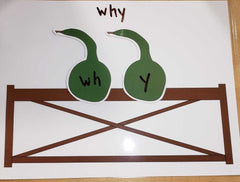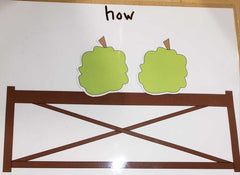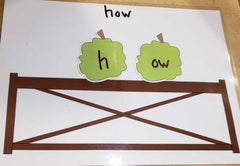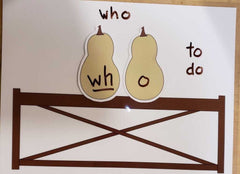Here is a great spelling activity! The Gourds and Fences manipulative shown throughout can be downloaded at the end of the blog.

I have a student who is learning her WH question words. As we teach in our Foundations for Teaching Reading, Writing & Spelling educator course, these words go together because "words that have the same job often share the same spelling." Like all spelling lessons, we begin with the student's oral language knowledge, using words in context (talking, reading, and writing). Using oral language means we analyze and identify the sounds we hear, then we map the letters to those sounds by connecting the spellings to the sounds.
Here is the lesson:
-
First I told my student we were going to learn important question words. These words go together because they are used when we ask questions. We spent time talking about questions and she helped generate a list of question words: who, what, where, when, why, and how.
-
We discussed our word study rule: "Words that have the same job often share the same spelling." Then I wrote all the words down and had her copy them, omitting the word "how." I told her we would write that word on another day. We discovered these words shared the spelling of WH. She highlighted the WH's in all the words.
-
She spent the week writing sentences using three of the words: what, when, and where.
-
The next week my student made Caution Word cards for each question word. Then, using household items I played the game: "I am thinking of something..." My student had to guess what I was thinking by asking questions using the target words: what, when, and where.
-
Every time she asked a question, my student had to hold up the Caution Word card that matched the question word she was using. (We limited the question words to three, creating a limited set of options to aid her word from memory for reading and spelling those words. Therefore, my student only had to read and quickly locate three of the original five words at once.)
-
Once she understood the game, we took turns thinking of household items. When I was the guesser, I held up my Caution Word cards for her to see.
-
We added "how" to her word list and discussed sound and letter confusions between the words "who" and "how." My student did more writing with question words throughout the week.
-
Next we used the gourds to practice mapping sounds and letters together to further aid her word form memory. First I wrote the word on the laminated fence sheet. My student and I read the word. She had to listen and count the sounds by lining gourds on the fence.
-
Once she identified the number of sounds, she wrote the letters on each gourd to match the sounds, "saying sounds as I write!" We reread and discussed the word's meaning.
-
We completed this activity with all the WH words.
-
We ended our lesson by adding the question word "which." This led to a great lesson on another word study rule: "Words that sound alike but have different meanings usually have different spellings." So we wrote the word "witch" and then learned and practiced the "Smack Dab" TCH rule.
These manipulatives are great to use to help teach other spelling rules, sound-to-letter connection, alphabet knowledge, sorting, grammar, and word study concepts. Use them to add some fall flavor to your language arts!
To make them reusable, we recommend laminating the pages and writing with wet erase vis-a-vis markers.

Marking sounds with gourds

Writing letters to match the sounds

Noticing other words that are spelled in similar ways.
Access the free download here: Fence & Gourds Manipulatives

